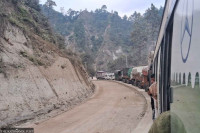Editorial
Active cholera threat
It is usually after cases emerge that the authorities wake up to take charge of the situation.
The Ministry of Health and Population on Sunday confirmed cholera infection in two people in Kathmandu. Doctors have confirmed the presence of Vibrio cholera 01 Ogawa serotype. With the onset of the monsoon, Nepal becomes highly vulnerable to water-borne and vector-borne diseases like diarrhoea, dysentery and Kala-Azar. While sporadic cases have been reported in Kathmandu Valley, the numbers are still manageable for now. Still, the highly infectious nature of cholera could mean that any negligence in maintaining hygiene standards, mainly related to drinking water, could see a spike in the number of cases pretty quickly with severe consequences.
Nepal is a cholera endemic country, and cases of infection are detected yearly. And despite its perennial reoccurrence, little is done to raise awareness promptly. Dissemination of information ahead of the monsoon could be one way of raising awareness, but it is usually left to the very end when cases emerge that the authorities wake up to take charge of the situation, which is constantly too little too late. However, it is not just a matter of launching an awareness drive against water-borne diseases; it is also about ensuring safe drinking water for the people.
Maintaining general hygiene standards is critical for tackling the spread of water-borne and vector-borne diseases. Garbage usually lies dumped on the roadside for weeks on end; open sewers lie alongside people’s homes, and the practice of dumping untreated sewage directly into rivers increases the risk of contaminating drinking water sources which leads to a rise in the number of cases yearly. Typically, it is the economically disadvantaged who are most exposed to the risk of contracting this deadly disease. It is the ineptitude on the part of the administration in providing safe drinking water and maintaining general hygiene standards that cause this yearly outbreak.
This is no time for complacency with the effects of the pandemic waning and waxing at frequent intervals. Despite being easily treatable, people tend to avoid seeking medical help until the situation turns serious. Last year, an outbreak in Krishnanagar Municipality in Kapilvastu led to the deaths of at least four people and left several hundred seeking medical help at various hospitals. And to have the threat of another outbreak lurking in the capital puts the spotlight on our mismanaged efforts so far.
Several government agencies, including those under the Ministry of Health, Ministry of Water Supply and Sanitation, Ministry of Science and Technology, and non-governmental organisations, have been pooling millions of rupees every year to improve water and sanitation facilities, but they have failed to produce the desired results. The only way out of this crisis is constant monitoring and improving our hygiene standards to ensure that the people and the authorities alike do not take the threat of water-borne disease lightly.




 6°C Kathmandu
6°C Kathmandu














